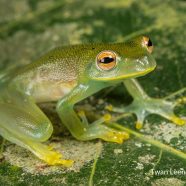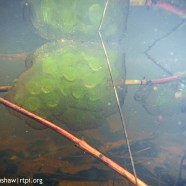Spring Salamander
Hey look – a hot-dog with eyes! Wait, that’s a Spring Salamander (Gyrinophilus porphyriticus)! This large, lung-less salamander is a common resident in the many springs and streams that run through our local forests. It’s stature and bright coloration make it stand out, but also serve as protection from predators. Spring salamanders can grow to over eight inches in length and produce noxious skin secretions while using their color to mimic even more toxic species. It isn’t a salamander any predator would want to mess with, and it probably wouldn’t taste anything...
Read MoreCocobolo Nature Reserve Monitoring
I’m leaving Saturday for another round of research and monitoring on the endangered Limosa Harlequin Frog (Atelopus limosus) monitoring with Alex Shepack, Michael Roy, and Abel Batista in the wonderful Cocobolo Nature Reserve in Eastern Panama. We’re looking for more clues on the enigmatic behavior of the deadly amphibian chytrid fungus in the area and the mechanisms that allow some local frogs to survive. In addition we’ll be setting up opportunities for student research on the project through the Roger Tory Peterson Institute of Natural History and Yale...
Read MoreBouncing Babies
Here we have some bouncing baby…umm, boys and girls I would guess. These spotted salamander (Ambystoma maculatum) babies will soon be hatching from their globular masses and become veracious predators in the little vernal pools in which they temporarily reside. As they feed and grow, they will be racing against the clock in order to develop from free swimming legless tadpoles into four legged land dwellers before their nursery pool dries out towards the end of the summer. Talk about rapid development! Elyse Henshaw Conservation Technician
Read MoreTale of Two April Climates
The first half of April 2015 was a Tale of Two Climates: when compared to long-term averages, New England was cool to cold and dry, sometimes exceptionally so, while the Mid-Atlantic was warm and wet, sometimes ridiculously so. Fortunately since then it has balanced out to some degree (pun intended) and conditions have moderated in both regards. In my opinion we seem to be at a relatively average place in terms of “green out”, with buds and leaves near where they “should” be for our returning birds and emerging insects. Scott Kruitbosch Conservation & Outreach...
Read MoreEastern Phoebe Wet & Cold
This Eastern Phoebe is wet and cold today, and I had to crank up the ISO to get a recognizable photo of it in these dreary and foggy conditions. You can also see the snow on the ground behind the bird as we continue to have cover throughout the region. Even though it feels like a “warm” day we are still below our normal temperatures. Despite that the southerly flow has brought in migrants like this one. Have you had your Phoebe yet? Scott Kruitbosch Conservation & Outreach Coordinator
Read More








